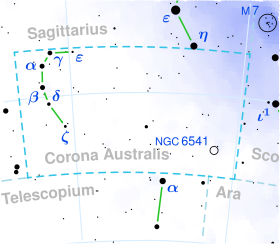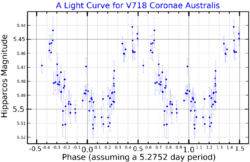Astronomy:V718 Coronae Australis
| Observation data Epoch J2000.0 Equinox (celestial coordinates) | |
|---|---|
| Constellation | Corona Australis |
| Right ascension | 18h 39m 35.15900s[1] |
| Declination | −43° 11′ 09.1691″[1] |
| Apparent magnitude (V) | 5.43±0.01[2] |
| Characteristics | |
| Evolutionary stage | AGB[3] |
| Spectral type | M2 III[4] |
| B−V color index | +1.63[5] |
| Variable type | LB:[6] |
| Astrometry | |
| Radial velocity (Rv) | 28.5±0.8[7] km/s |
| Proper motion (μ) | RA: −32.414[1] mas/yr Dec.: −43.168[1] mas/yr |
| Parallax (π) | 5.1919 ± 0.0901[1] mas |
| Distance | 630 ± 10 ly (193 ± 3 pc) |
| Absolute magnitude (MV) | −1.03[8] |
| Details | |
| Mass | 1.45[9] or 2[10] M☉ |
| Radius | 101±5[11] R☉ |
| Luminosity | 1,001[12] L☉ |
| Temperature | 3,698±122[13] K |
| Other designations | |
| Database references | |
| SIMBAD | data |
V718 Coronae Australis (HD 171697; HR 6991; V718 CrA) is a solitary variable star[15] located in the southern constellation Corona Australis. It is faintly visible to the naked eye as a red-hued point of light with an apparent magnitude of 5.43.[2] Gaia DR3 parallax measurements imply a distance of 630 light years[1] and it is currently receding with a heliocentric radial velocity of 28.5 km/s.[7] At its current distance V718 CrA's brightness is diminished by 0.37 magnitudes due to interstellar dust[16] and it has an absolute magnitude of −1.03.[8]
This object was first noticed to be potentially variable by Olin J. Eggen in 1973.[18] Its variability was confirmed in 1999 after subsequent observations and was given the variable star designation V718 Coronae Australis.[19] Observations from Koen & Laney (2000) reveal that V718 CrA has two periods: one lasting 5.37 days and the other lasting 71.1 days.[10] It is a slow irregular variable of subtype Lb that fluctuates between 5.45 and 5.51 in the Hipparcos passband.[6]
V718 CrA has a stellar classification of M2 III, indicating that it is an evolved red giant. It is currently on the asymptotic giant branch,[3] fusing hydrogen and helium shells around an inert carbon core. It has 1.45 times the mass of the Sun[9] but it has expanded to 101 times the Sun's radius.[11] It radiates 1,001 times the luminosity of the Sun[12] from its enlarged photosphere at an effective temperature of 3,698 K.[13] Oscillation measurements from Koen & Laney (2000) yield a mass of 2 M☉.[10]
References
- ↑ 1.0 1.1 1.2 1.3 1.4 Vallenari, A. et al. (2022). "Gaia Data Release 3. Summary of the content and survey properties". Astronomy & Astrophysics. doi:10.1051/0004-6361/202243940 Gaia DR3 record for this source at VizieR.
- ↑ 2.0 2.1 Høg, E.; Fabricius, C.; Makarov, V. V.; Urban, S.; Corbin, T.; Wycoff, G.; Bastian, U.; Schwekendiek, P. et al. (March 2000). "The Tycho-2 catalogue of the 2.5 million brightest stars". Astronomy and Astrophysics 355: L27–L30. ISSN 0004-6361. Bibcode: 2000A&A...355L..27H.
- ↑ 3.0 3.1 Eggen, Olin J. (July 1992). "Asymptotic giant branch stars near the sun". The Astronomical Journal 104: 275. doi:10.1086/116239. ISSN 0004-6256. Bibcode: 1992AJ....104..275E.
- ↑ Houk, Nancy (1978). Michigan catalogue of two-dimensional spectral types for the HD stars: Declinations −53° to −40°. 2. Bibcode: 1978mcts.book.....H.
- ↑ Corben, P. M. (April 1971). "Photoelectric Magnitudes and Colours for Bright Southern Stars". Monthly Notes of the Astronomical Society of South Africa 30 (4): 37. ISSN 0024-8266. Bibcode: 1971MNSSA..30...37C.
- ↑ 6.0 6.1 Samus’, N. N.; Kazarovets, E. V.; Durlevich, O. V.; Kireeva, N. N.; Pastukhova, E. N. (January 2017). "General catalogue of variable stars: Version GCVS 5.1". Astronomy Reports 61 (1): 80–88. doi:10.1134/S1063772917010085. ISSN 1063-7729. Bibcode: 2017ARep...61...80S.
- ↑ 7.0 7.1 Gontcharov, G. A. (November 2006). "Pulkovo Compilation of Radial Velocities for 35,495 Hipparcos stars in a common system". Astronomy Letters 32 (11): 759–771. doi:10.1134/S1063773706110065. ISSN 1063-7737. Bibcode: 2006AstL...32..759G.
- ↑ 8.0 8.1 Anderson, E.; Francis, Ch. (May 2012). "XHIP: An extended hipparcos compilation". Astronomy Letters 38 (5): 331–346. doi:10.1134/S1063773712050015. ISSN 1063-7737. Bibcode: 2012AstL...38..331A.
- ↑ 9.0 9.1 Kervella, Pierre; Arenou, Frédéric; Thévenin, Frédéric (20 December 2021). "Stellar and substellar companions from Gaia EDR3. Proper-motion anomaly and resolved common proper-motion pairs.". Astronomy & Astrophysics 657: A7. doi:10.1051/0004-6361/202142146. ISSN 0004-6361. Bibcode: 2022A&A...657A...7K.
- ↑ 10.0 10.1 10.2 Koen, C.; Laney, D. (21 January 2000). "Rapidly oscillating M giant stars?". Monthly Notices of the Royal Astronomical Society 311 (3): 636–648. doi:10.1046/j.1365-8711.2000.03127.x. ISSN 0035-8711. Bibcode: 2000MNRAS.311..636K.
- ↑ 11.0 11.1 Kervella, P.; Thévenin, F.; Di Folco, E.; Ségransan, D. (October 2004). "The angular sizes of dwarf stars and subgiants. Surface brightness relations calibrated by interferometry". Astronomy & Astrophysics 426 (1): 297–307. doi:10.1051/0004-6361:20035930. ISSN 0004-6361. Bibcode: 2004A&A...426..297K.
- ↑ 12.0 12.1 McDonald, I.; Zijlstra, A. A.; Boyer, M. L. (21 November 2012). "Fundamental parameters and infrared excesses of Hipparcos stars: Parameters and IR excesses from Hipparcos". Monthly Notices of the Royal Astronomical Society 427 (1): 343–357. doi:10.1111/j.1365-2966.2012.21873.x. ISSN 0035-8711. Bibcode: 2012MNRAS.427..343M.
- ↑ 13.0 13.1 Stassun, Keivan G. et al. (9 September 2019). "The Revised TESS Input Catalog and Candidate Target List". The Astronomical Journal 158 (4): 138. doi:10.3847/1538-3881/ab3467. Bibcode: 2019AJ....158..138S.
- ↑ "V718 Corona Australis". SIMBAD. Centre de données astronomiques de Strasbourg. http://simbad.u-strasbg.fr/simbad/sim-basic?Ident=V718+Corona+Australis.
- ↑ Eggleton, P. P.; Tokovinin, A. A. (11 September 2008). "A catalogue of multiplicity among bright stellar systems". Monthly Notices of the Royal Astronomical Society 389 (2): 869–879. doi:10.1111/j.1365-2966.2008.13596.x. ISSN 0035-8711. Bibcode: 2008MNRAS.389..869E.
- ↑ Gontcharov, George A.; Mosenkov, Aleksandr V. (28 September 2017). "Verifying reddening and extinction for Gaia DR1 TGAS main sequence stars". Monthly Notices of the Royal Astronomical Society 472 (4): 3805–3820. doi:10.1093/mnras/stx2219. ISSN 0035-8711. Bibcode: 2017MNRAS.472.3805G.
- ↑ EAS (1997). "The HIPPARCOS and TYCHO catalogues". Astrometric and Photometric Star Catalogues Derived from the ESA Hipparcos Space Astrometry Mission. ESA SP Series (Noordwijk, Netherlands: ESA Publications Division) 1200. ISBN 9290923997. Bibcode: 1997ESASP1200.....E. https://cdsarc.cds.unistra.fr/viz-bin/ftp-index?/ftp/cats/more/HIP/cdroms/cats. Retrieved 18 March 2023.
- ↑ Eggen, O. J. (September 1973). "The classification of intrinsic variables. IV. Very-small-amplitude, very-short-period red variables". The Astrophysical Journal 184: 793. doi:10.1086/152371. ISSN 0004-637X. Bibcode: 1973ApJ...184..793E.
- ↑ Kazarovets, E. V.; Samus, N. N.; Durlevich, O. V.; Frolov, M. S.; Antipin, S. V.; Kireeva, N. N.; Pastukhova, E. N. (January 1999). "The 74th Special Name-list of Variable Stars". Information Bulletin on Variable Stars 4659: 1. ISSN 0374-0676. Bibcode: 1999IBVS.4659....1K.
<ref> tag with name "Gould1879" defined in <references> is not used in prior text.
 |



